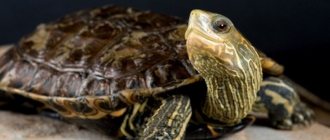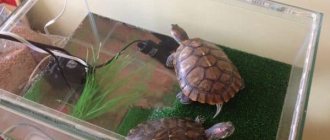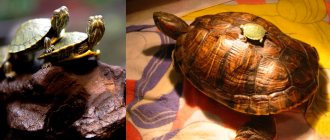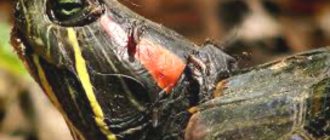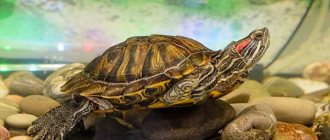How long can a turtle hibernate?
The duration of hibernation in natural conditions is from 4 to 6 months. The turtle prepares a hole in the ground, where it goes and falls asleep.
Interesting materials:
How hard does the kebab cook? How to sync sounds to iPhone? How to scan to Canon 4410? How to scan with HP Ink Tank 315 printer? How to scan directly into Word? How to tell a stranger that I like her? How to tell a woman that she is beautiful? How to send a link in Viber? How to stitch a video with subtitles? How are compound cardinal numerals declined?
Features of hibernation in domestic turtles
Red-eared turtles living at home hibernate only in rare cases. This condition is observed in single individuals or is achieved artificially due to manipulations by the owner.
Turtles hibernate at low temperatures, so comfortable housing conditions that maintain optimal temperatures eliminate this need. Due to the reduction in daylight hours in winter, reptiles sleep more than usual, but do not lose activity.
IMPORTANT! A wild turtle brought into the house shortly before falling asleep can go into hibernation. In this case, the animal does not have time to adapt to new living conditions.
If you try to lull a turtle at home, you may encounter the following problems:
- Deviation of humidity and temperature indicators. Too low levels can lead to the death of the pet.
- Penetration of insects. Intruders entering the wintering area can damage the sleeping turtle.
- Deterioration of condition. Hibernation takes a lot of resources from the body, so sick animals run the risk of complications.
The feasibility of artificial hibernation and preparation rules
The hibernation state has a positive effect on the reproductive system of reptiles, so experienced breeders send their pets into hibernation on their own.
IMPORTANT! If you have insufficient experience and there is no good reason, it is not recommended to hibernate a turtle, since caring for it at home is very problematic.
Preparing for hibernation includes the following steps:
- Increasing the size of the diet 2 months before falling asleep. During the winter, turtles do not eat and lose almost half of their weight. Without a layer of fat, a supply of nutrients and vitamins, the animal may die.
- Canceling feeding 1 week before wintering. Additionally, the water level decreases.
- Smooth decrease in temperature over 10 days. Turtles are lethargic at temperatures below 15°, and at temperatures below 10° they go into hibernation.
- Gradual reduction of daylight hours over 10 days. Reduce lamp operating hours, turn off filters and increase room humidity.
- Bathe your reptile on the last day before wintering. A warm water bath will help you relax and empty your bowels.
IMPORTANT! Check the sleeping turtle every 3 days and spray the soil with water to maintain moisture.
Remember that during hibernation it is prohibited:
- wake up and put your pet back to sleep;
- awaken the reptile before daylight hours increase;
- carry out bathing, which triggers the process of urination when the shell comes into contact with water;
- continue sleeping with a strong decrease in body weight (the animal loses more than 10% within 1 month);
- Allow long-term cooling below 0°.
In addition to the terrarium, you can use a special plastic container. Before using it you must:
- Fill 10-30 cm with substrate (peat, sand, moss, sphagnum), dry leaves or decorative pieces of bark. The selected container should be well ventilated, and the substrate should remain dry even at high humidity.
- Cool on the balcony, in the basement or in the refrigerator for several days.
- Place in a cool, but draft-free place at a temperature of 6° to 10°. There is no need to warm the hibernation site, as this can provoke early awakening and disorientation of the animal.
After waking up, the turtle is bathed in warm baths to restore its usual temperature and start internal processes.
IMPORTANT! If after wintering the reptile shows lethargy and looks exhausted, then consult a veterinarian to find out the cause of the symptoms.
Swamp turtle in its natural habitat
The habitat of marsh turtles is unusually wide. Any pond or river with standing water is an excellent home for these amphibians. The life of swamp turtles is simple and measured, since any pond with stagnant water is full of fry, insects, tadpoles, worms, as well as algae, which the turtle feeds on throughout the summer season. Summer is a very important period for a turtle, since at this time the amphibian needs to lay several clutches of eggs and accumulate a significant amount of fat reserves, which will be sufficient to maintain the animal’s life while it is in hibernation.
Preparation
So, how do red-eared turtles hibernate at home? About 2 months before hibernation, switch your pet to an enhanced diet so that she can store as many nutrients as possible
This is important because during hibernation animals lose weight by almost 2 times. It is useful to give your turtle special nutritional supplements (they are sold at the pet supply store)
But a week before bedtime, the animal needs to stop feeding altogether.
The ideal temperature during sleep is from 1 to 6 degrees Celsius. This regime can be ensured by placing the animal, for example, in the basement. However, be careful. Hypothermia is fatal for red-eared turtles. It is also necessary to maintain optimal humidity conditions. It can be provided by moistened moss and leaves. This environment is well ventilated.
Awakening
A few words about how to bring a red-eared turtle out of hibernation. If conditions are good, then the duration of hibernation is 3-5 months. You cannot feed the animal immediately after waking up; you need to wait until its digestive system starts working. Wash the animal in warm water, this will speed up the awakening process. You can't let hibernation be too long. Gradually increase the temperature of the reptile, thereby stimulating the awakening process. If you do not do this, the animal may become completely weak.
Hibernation is a completely natural process for turtles living in nature, but for indoor pets, wintering is often not relevant. This is a rather complicated procedure and a huge burden on the turtle’s body, so it is not recommended to hibernate turtles on your own, only under the supervision of a specialist.
The first signs that it is time for the animal to winter can be observed in late October - early November. The turtle becomes less active, its appetite decreases, it tries to bury itself in the ground or almost never leaves its shelter. In the natural environment, hibernation lasts from 3 to 5 months, all vital processes of the body slow down, and accumulated resources are used to maintain life. There are also advantages to wintering: it is indicated for turtles from which the owners plan to get offspring, since hormonal levels are adjusted, life expectancy increases, and the activity of the internal glands is maintained.
It is worth remembering that under artificial conditions hibernation should not be so long: for small breeds it is 8-10 weeks, for large breeds it is 12-14. The animal must be absolutely healthy, and a suitable microclimate must be maintained constantly, otherwise the turtle may not emerge from hibernation. If you are not confident in your abilities, it is easier to maintain normal conditions: temperature at 27-28 degrees, frequent bathing, good nutrition. Does your turtle eat well? – go to the clinic, a specialist will give her an injection of vitamins.
Signs of hibernation
The state of wintering is often confused with death. To put your mind at ease, check your red-eared slider for several points that will help you understand that it is definitely hibernating:
- Jaws. Try to pull your lower jaw down and leave your mouth open. The reptile should try to close its jaws.
- Eyes. A cold metal spoon placed against your pet's eye should trigger the corneal reflex. If the turtle tries to retract the disturbed organ or opens its eyelids, then there is no reason to worry.
- Reaction to heat. A hibernating red-eared turtle placed in a container of warm water (30°C) will begin to move its paws.
Otherwise, signs of hibernation include:
- Decreased activity. The pet behaves lethargically, hides in a corner of the aquarium, remaining motionless, and refuses to leave its house for a walk.
- Poor appetite. In addition to loss of activity, the reptile refuses its favorite food and reduces its usual amount of food.
- Increased sleep duration. Long periods of rest are accompanied by frequent yawning.
Rules for caring for a sleeping turtle
If you notice the first signs of the approaching winter in a red-eared slider, be sure to consult with a veterinarian, who will examine it and tell you what needs to be done if the reptile actually hibernates.
During the winter, adhere to the following recommendations:
- Lower the water level. The turtle burrows into the ground, where it can sleep for a long time without rising to the surface. Oxygen is obtained by special membranes in the cloaca and oral cavity.
- Turn off additional lighting. The pet will have to go to the bottom to maintain warmth, so turn off the filtration and monitor the water level. Excessive movement will destroy the thermal layer, and a low water level will lead to freezing to the very bottom.
- Avoid feeding. Thanks to slow digestion, the turtle digests the food eaten the day before over the course of several months.
- Monitor your pet's well-being. Domestic turtles fall asleep as early as November, when daylight hours begin to shorten, and sleep for about 4 months. It happens that the reptile does not wake up even in February. In this case, you have to wake up the pet yourself.
If the turtle looks active or it is February, then gradually increase the temperature and light to normal. The recovery period takes from 5 to 7 days.
You can feed your pet only after returning to normal activity, but not earlier than the 5th day.
IMPORTANT! After winter is over, take your pet to a veterinary clinic for an examination. The doctor will identify possible complications and prescribe timely treatment if necessary.
Is it possible to sleep in a refrigerator?
Biologists recommend placing turtles in the refrigerator during hibernation, because it is easy to maintain the same temperature.
First, the turtle is placed in a cardboard box, which is not much larger in size than the animal, the voids are filled with torn paper, and placed in a refrigerator with a temperature of +12 degrees. The temperature is reduced every day by 1 degree until it reaches +5. To overwinter in the refrigerator, the turtle can be buried in a substrate of turf soil, sand and fine gravel. The layer of mixture above the turtle should be within 8-9 cm, but to prevent it from suffocating, the refrigerator door must be opened for 10-15 minutes every 2 days.
How to avoid wintering?
To prevent the turtle from hibernating, make sure that there are optimal temperature conditions for keeping it:
- Water. The temperature should be 22°-28°. Any decrease will lead to a decrease in activity and a gradual slowdown of internal processes.
- Land. The island is used by turtles for heating, so the temperature here can reach up to 32°.
The cause of hibernation can also be a lack of vitamins. Make sure there is enough ultraviolet light or get a vitamin shot at a veterinary clinic. This will prevent the turtle from hibernating due to lack of nutrients.
Due to the labor-intensive process and high risks, it is not recommended to put the reptile into hibernation. If in nature the process occurs naturally and its time is determined by biological rhythms, then at home the responsibility falls solely on the owner.
Other interesting articles
- Aquarium fish cardinal: Types, contents For everyone who has an aquarium in their home, the cardinal fish is one of the most suitable…
- Zebra fish: types and contents The aquarium fish pseudotropheus or zebra from the cichlid family naturally lives in the lake area…
- Minor fish: maintenance and care, compatibility, breeding General information Minor is an aquarium fish of the Characin family. Under natural conditions, it lives in…
Habitats
The marsh turtle is distributed in North-West Africa, in Southern and Central Europe, to Smolensk and Ulyanovsk in the north, in Asia - in the east to the Irgiz River and the lower reaches of the Syrdarya, and in the south - to Iran, Iraq and Asia Minor.
It can be found in forest, forest-steppe and steppe areas. The marsh turtle is quite unpretentious in its choice of habitats and settles in bodies of water with weak currents; also common in lakes and floodplain channels among floodplains.
Prefers reservoirs with sloping banks overgrown with reeds, reeds, cattails and other wetland plants.
Preparation
In the fall, when the turtle is about to hibernate, it begins to eat less, no need to be surprised. Metabolism in turtles is truly “turtle-like”, the activity of the digestive system slows down, the body digests food within 2-4 weeks.
There is no need to hibernate your turtle if there is undigested food left in its intestines. The gases that are released can cause serious harm to the health of the turtle. If you notice that the reptile has become slow and inactive, stop feeding it; for it, hunger is better than feeding during this period. The ambient temperature can be reduced slightly and the daylight hours can be shortened.
But 2 months before hibernation, the turtle needs to be well fed so that it can accumulate enough nutrients and useful substances in its body. After all, during wintering the reptile loses up to 50% of its weight.
Warm baths, which can be done for the turtle 1-2 days before hibernation, will help activate digestion. During bathing, it will be saturated with water, since it has the ability to absorb water through the skin, and will get rid of food debris in the intestines.
On the eve of hibernation, the turtle should be healthy and of normal weight. If the weight and general condition of the animal cause you concern, you should not artificially hibernate it. And if she falls asleep on her own, keep her in a warm and dry terrarium with good ventilation.
In nature, a turtle hibernates by burying itself in sand or silt; you should try to create the same conditions for it at home. It is not necessary to take the mud home, but dry, clean sand in a box will do just fine. Fallen leaves or moss will be a good material for our purposes; thanks to them, the terrarium will have normal temperature and air humidity.
You can do without sand and leaves if you put small pieces of paper in the box. Newspaper is not suitable for these purposes - it contains harmful printing ink. The box with the sleeping turtle should be kept in a dry room with above-zero temperatures.
It is advisable to maintain the temperature during hibernation at the same level, within +5-6 degrees. Temperatures from +2 to +10 degrees Celsius are allowed. If you keep a sleeping turtle for a long time at a temperature of +2 and below, or +10 and above, it can become seriously ill or die.
The duration of wintering depends on the size - for small turtles, 3-3.5 months will be enough for hibernation. The red-eared slider spends 4-5 months in hibernation.
Description of the species
Red-eared turtles in nature reach 30 cm in length (based on the shell), but when kept at home they rarely grow to that size. Females are significantly larger than males. The shell of juveniles is bright green, but as the turtle matures it becomes brown or olive in color with patterns of bright yellow stripes.
The head, neck and paws of the animal are decorated with a series of white and black stripes. The species got its name due to the bright red spots near the eyes. These “ears” can also be deep orange or rich yellow. It is thanks to its bright appearance that the red-eared turtle has become one of the most popular exotic pets.
She prefers to lead a sedentary lifestyle, but swims very quickly in the water and is extremely curious. May hiss and snort, expressing his displeasure and anxiety. When defending its life, it can inflict serious wounds with the sharp claws of its hind legs. In the cold season, a phenomenon called suspended animation, or hibernation, occurs for red-eared turtles.
Pleasant awakening
Coming out of hibernation is an important moment in the life of a turtle, and it needs help to cope with this task. How to bring a turtle out of hibernation? All autumn reserves are used up, the turtle wakes up weak, exhausted and vulnerable to infections. At this moment, she needs care and quality nutrition more than ever.
After the turtle comes out of hibernation, it is warmed with a lamp or fan heater, then a “bath day” is arranged - in a small container with warm water. The turtle should bathe for about 10 minutes, this will restore the water balance in its body.
After hibernation, water procedures must be repeated every day for a week. They can be stopped when the reptile urinates for the first time. At first, her urine will be thick and dark yellow, but gradually the toxins will come out and it will become light in color again.
Now you can “sit down at the table,” of course, if its appetite has awakened along with the turtle. At first, the reptile may refuse food, this is normal, gradually everything will recover.
What signs can be used to determine that a turtle has safely emerged from hibernation? A healthy reptile's tongue will be pink or orange, without a coating. If it is bright red, the animal may be infected with something. The eyes should be clear and clean, also without plaque or discharge.
Hibernation is a completely natural process for turtles living in nature, but for indoor pets, wintering is often not relevant. This is a rather complicated procedure and a huge burden on the turtle’s body, so it is not recommended to hibernate turtles on your own, only under the supervision of a specialist.
The first signs that it is time for the animal to winter can be observed in late October - early November. The turtle becomes less active, its appetite decreases, it tries to bury itself in the ground or almost never leaves its shelter. In the natural environment, hibernation lasts from 3 to 5 months, all vital processes of the body slow down, and accumulated resources are used to maintain life. There are also advantages to wintering: it is indicated for turtles from which the owners plan to get offspring, since hormonal levels are adjusted, life expectancy increases, and the activity of the internal glands is maintained.
It is worth remembering that under artificial conditions hibernation should not be so long: for small breeds it is 8-10 weeks, for large breeds it is 12-14. The animal must be absolutely healthy, and a suitable microclimate must be maintained constantly, otherwise the turtle may not emerge from hibernation. If you are not confident in your abilities, it is easier to maintain normal conditions: temperature at 27-28 degrees, frequent bathing, good nutrition. Does your turtle eat well? – go to the clinic, a specialist will give her an injection of vitamins.
The first wintering of a marsh turtle
Surprisingly, little turtles go into their first winter hibernation immediately after birth, without ever leaving their nest. The thing is that the habitat of swamp turtles is often not pleasant in the long summer, so warm days are only enough for small turtles buried deep in the sand to form in their shells. Reptile eggs are completely dependent on the sun, so warm days are only enough for the turtles to hatch, since the incubation period ranges from 54 to 90 days, depending on the ambient temperature.
Turtles hatch in mid-autumn, when it is already starting to get colder and there is not enough food for them, so they do not leave their underground nest, hibernating where they emerged from the shell. Turtles do not have stored fat, but they have large sacs of yolk on their abdomens, which help them survive the winter cold while hibernating. Newborn turtles are literally frozen in their nests, but when spring arrives, they wait again and emerge into sunlight for the first time.


